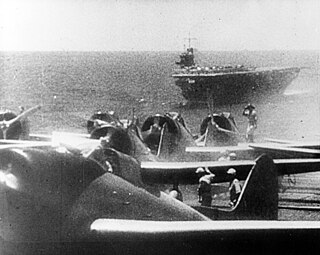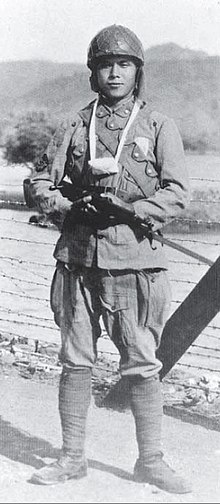
Airborne forces are ground combat units carried by aircraft and airdropped into battle zones, typically by parachute drop or air assault. Parachute-qualified infantry and support personnel serving in airborne units are also known as paratroopers.

The Southern Expeditionary Army was a general army of the Imperial Japanese Army during World War II. It was responsible for all military operations in South East Asian and South West Pacific campaigns of World War II. Its military symbol was NA.

The Aichi D3A Type 99 Carrier Bomber is a World War II carrier-borne dive bomber. It was the primary dive bomber of the Imperial Japanese Navy (IJN) and was involved in almost all IJN actions, including the attack on Pearl Harbor.

The Aichi B7A Ryusei was a large and powerful carrier-borne torpedo-dive bomber produced by Aichi Kokuki for the Imperial Japanese Navy Air Service during the Second World War. Built in only small numbers and deprived of the aircraft carriers it was intended to operate from, the type had little chance to distinguish itself in combat before the war ended in August 1945.

The Special Naval Landing Forces were naval infantry units of the Imperial Japanese Navy (IJN) and were a part of the IJN Land Forces. They saw extensive service in the Second Sino-Japanese War and the Pacific theatre of World War II.

Giretsu was an airlifted special forces unit of the Imperial Japanese Army formed from Army paratroopers, in November 1944 as a last-ditch attempt to reduce and delay Allied bombing raids on the Japanese home islands. The Giretsu Special Forces unit was commanded by Lieutenant General Michio Sugahara.
This article covers the Japanese garrisons on the by-passed Pacific islands from 1944 to 1945, including the Japanese mandated territory of the South Seas Mandate.

The Mitsubishi G3M was a Japanese bomber and transport aircraft used by the Imperial Japanese Navy Air Service (IJNAS) during World War II.

The Nakajima A6M2-N was a single-crew floatplane based on the Mitsubishi A6M Zero Model 11. The Allied reporting name for the aircraft was Rufe.

The Special Type 2 Launch Ka-Mi was the first amphibious tank of the Imperial Japanese Navy (IJN). The Type 2 Ka-Mi was based on the Imperial Japanese Army's Type 95 Ha-Go light tank with major modifications. It first saw combat service during the Guadalcanal campaign in late 1942.

Nagara (長良) was the lead ship of her class of light cruiser in the Imperial Japanese Navy. She was named after the Nagara River in the Chūbu region of Japan.

Chitose (千歳) was a warship of the Imperial Japanese Navy that served from 1938 to 1944, seeing service as a seaplane carrier and later as a light aircraft carrier during World War II. In her initial guise as a seaplane carrier, she first saw service during the Second Sino-Japanese War in 1938, and subsequently played a key role in the Imperial Japanese Navy's development of a network of seaplane bases on the islands of the Pacific Ocean. After the outbreak of World War II in the Pacific, she took part in the Philippines campaign, the Dutch East Indies campaign, the Battle of Midway, and the Guadalcanal campaign, during which she was damaged in the Battle of the Eastern Solomons and also saw service related to the Battle of Cape Esperance.
Teishin Shudan was a Japanese special forces/airborne unit during World War II. The unit was a division-level force, and was part of the Imperial Japanese Army Air Force (IJAAF). The Teishin units were therefore distinct from the marine parachute units of the Special Naval Landing Forces.

The Battle of Palembang was a battle of the Pacific theatre of World War II. It occurred near Palembang, on Sumatra, on 13–15 February 1942. The Royal Dutch Shell oil refineries at nearby Plaju were the major objectives for the Empire of Japan in the Pacific War, because of an oil embargo imposed on Japan by the United States, the Netherlands, and the United Kingdom after the Japanese invaded China and committed massive atrocities such as the rape of Nanking. With the area's abundant fuel supply and airfield, Palembang offered significant potential as a military base to both the Allies and the Japanese.

The Battle of Manado took place as part of the Japanese offensive to capture the Dutch East Indies. It occurred at Manado on the Minahasa Peninsula on the northern part of Celebes Island, from 11–12 January 1942. The battle was noted as the first time in Japanese history that the country had deployed paratroopers in a military operation.

The Yokosuka B4Y was a carrier-borne torpedo bomber used by the Imperial Japanese Navy Air Service from 1936 to 1943. The B4Y replaced the Mitsubishi B2M2 and was the last biplane bomber used operationally by the Imperial Japanese Navy. The Allied reporting name was "Jean".
Below is the order of battle for the Amoy Operation fought May 10–12, 1938, part of a campaign by the Imperial Japanese Navy to blockade the Republic of China during the Second Sino-Japanese War.
The 2nd Raiding Brigade, also known as the Takachiho Paratroopers, was an Imperial Japanese paratrooper unit. Part of the Japanese Army, the unit was notably involved in the Battle of the Philippines in 1945, during which it was almost completely destroyed.
Sanuki Maru (Japanese:讃岐丸) was a 1939-built cargo ship, requisitioned as a seaplane tender by the Imperial Japanese Navy during World War II.















